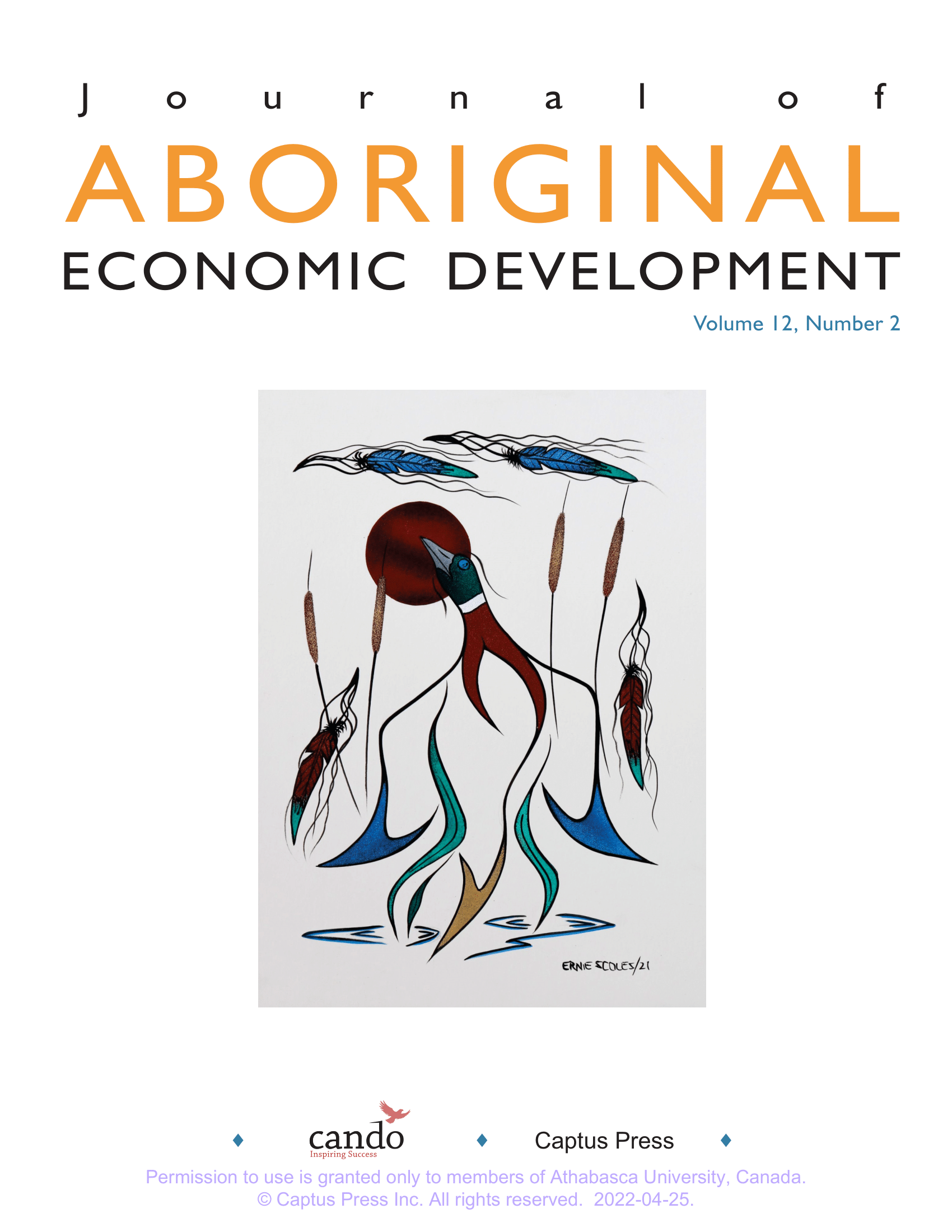First Peoples Economic Growth Fund: A Case Study of a Successful Aboriginal Financial Institution
DOI:
https://doi.org/10.54056/MSVM3359Keywords:
Boards of directors, Business, Business And Economics, Case studies, Casinos, Colonial government, Commercial banks, Communication, Community organizations, Economic development, Economic growth, Ethnic Interests, Financial institutions, Governance, Growth funds, Indigenous peoples, Native North Americans, Negotiations, Trade, Venture capital, Indigenous businesses, Indigenous Finance, Indigenous businesses in Canada, Indigenous economic development, Indigenous economic leadership, Indigenous economyAbstract
Start-Up Challenges Having identified lack of access to capital as a primary challenge, the AMC and the Province formed a group "to work on development of some sort of organization that would address that need" (Cramer, personal communication, November 6, 2020) and ultimately selected the AFI framework as the appropriate vehicle for change. Mr. Cramer described the makeup of the board as "a business board and not a political board, so it's made up of people with different business skills and when you bring them all together it's a very strong business and economic development board" (personal communication, November 6, 2020). The success of this method is compounded by the fact that the board is volunteer-based, which "for a board of directors of a financial organization [is] extremely rare, and also an extremely positive and strong part of our governance structure" (Cramer, personal communication, November 6, 2020). In what ways do AFIs engage with these challenges? * What are the benefits/limitations of attracting capital from each of the following: * Municipal/Provincial/Federal Colonial governments. * Indigenous Communities/Tribal Councils/Multi-community organizations. * Private Financial Institutions/Commercial Banks/Venture Capital * Are there examples of AFIs in Manitoba or Canada pursuing policies different from those of the First Peoples Economic Growth Fund (FPEGF)?
Downloads
References
The Aboriginal Financial Institutions Network. (August 2017). Investing in the Strengths of Aboriginal Entrepreneurs. https://nacca.ca/wp-content/uploads/2017/04/NACCA-TheAFIStory-Aug2017-WebVersion.pdf.
Brown, K., & Ketilson, L.H. (2009). Financing Aboriginal Enterprise Development: The Potential of Using Co-operative Models. University of Saskatchewan. online: https://usaskstudies.coop/documents/occasional-papers/financing-aboriginal-ent-dev.pdf.
Canada’s Public Policy Forum. (February 2016). Improving access to capital for Canada’s First Nation communities. https://ccednet-rcdec.ca/sites/ccednet-rcdec.ca/files/improving_access_to_capital_for_canadas_first_nation_communities.pdf.
Cash, M. (2018). Economic fund fuels Indigenous businesses in Manitoba. The Winnipeg Free Press. https://www.firstpeoplesfund.ca/docs/10th%20Anniversary—Wpg%20Free%20Press.%20October%203rd%20article..pdf.
First Peoples Economic Growth Fund. (2020, November). FPEGF Programs. https://www.firstpeoplesfund.ca/index.php.
Government of Canada (GC). (2003). 2003 November Report of the Auditor General of Canada. https://www.oag-bvg.gc.ca/internet/English/parl_oag_200311_09_e_12932.html#ch9hd3e.
Ketilson, L.H. (2014). Partnering to Finance Enterprise Development in the Aboriginal Social Economy. Canadian Public Policy, 40, S39–S49. online: https://www.muse.jhu.edu/article/543129.
Kuokkanen, R. (2011). From Indigenous Economies to Market-Based Self-Governance: A Feminist Political Economy Analysis. Canadian Journal of Political Science, 44(2), 275–297. https://doi.org/10.1017/s0008423911000126.
National Aboriginal Capital Corporations Association (NACCA). (2017). Barriers to Aboriginal entrepreneurship and options to overcome them. https://nacca.ca/wp-content/uploads/2017/04/Research-Module-3_NACCA-BDC_Feb14_2017.pdf.
National Aboriginal Capital Corporations Association (NACCA). (2017). Investing in the Strengths of Aboriginal Entrepreneurs. https://nacca.ca/wp-content/uploads/2017/04/NACCATheAFIStory-Aug2017-WebVersion.pdf.
National Aboriginal Capital Corporations Association (NACCA). (2017). Opportunities to improve the financial ecosystem for Aboriginal entrepreneurs and SMEs in Canada. https://nacca.ca/wp-content/uploads/2017/04/ProjectSummary_NACCA-BDC_Feb14_2017.pdf .
National Aboriginal Capital Corporations Association (NACCA). (2018). Supporting Your Vision Investing in Your Strengths. https://nacca.ca/wp-content/uploads/2018/11/NACCA_ANNUAL_REPORT_FINAL_WEB.pdf.
National Aboriginal Capital Corporations Association (NACCA). (2017). The impact of developmental finance on Aboriginal Entrepreneurship and Economic development in Canada: Insights from NACCA and BDC. https://nacca.ca/wp-content/uploads/2017/04/Research-Module-2_NACCA-BDC_Feb14_2017.pdf.
National Aboriginal Economic Development Board (NAEDB). (2015). Enhancing Aboriginal Financial Readiness for Major Resource Development Opportunities. http://www.naedb-cndea.com/reports/enhancing-aboriginal-financial-readiness.pdf.
National Indigenous Economic Development Board (NIEDB). (2018). Indigenous Economic Reconciliation: Recommendations on Reconciliation and Inclusive Economic Growth for Indigenous Peoples and Canada. http://www.naedb-cndea.com/reports/NIEDB%20-%20Economic%20Reconciliation%20-%20Final%20Report.pdf.
Paradis, R. (2017). For-Benefit Corporations and Urban Indigenous Community Economic Development: A Case Study of the Métis Economic Development Organization (MEDO) in Manitoba, Canada [Master’s Thesis, University of Winnipeg]. https://mspace.lib.umanitoba.ca/handle/1993/32561?show=full.
Downloads
Published
Issue
Section
License
Copyright (c) 2022 Cando

This work is licensed under a Creative Commons Attribution-NonCommercial-NoDerivatives 4.0 International License.




